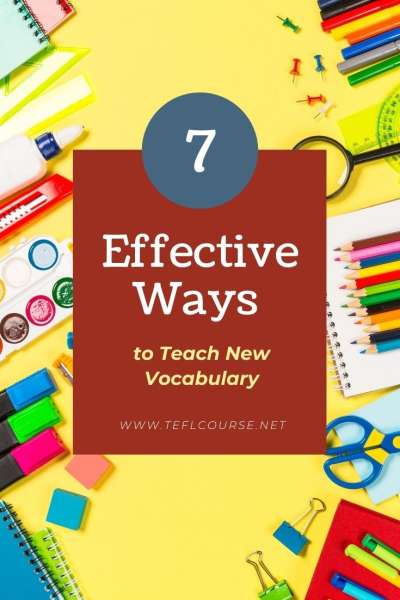7 Effective Ways to Teach New Vocabulary

Teaching new words should be organized as a vivid way for better understanding and a higher level of remembering. These activities are easy to implement with any group of students. They are also very adaptable to online teaching format.
Listen to this blog post:
1. Picture it
The easiest way to introduce new vocabulary is to show students colorful pictures. You can use flashcards, magazine images, digital pictures, picture dictionaries, or photographs when helping your students to visualize new words.
Also Read: Roles a Teacher has to Possess to Help Students Love English
2. Keep it Real
Students will remember new vocabulary better if you use real objects in the introduction. It’s also a great method of teaching kinesthetic-style learners as they’ll form stronger connections between real things and lexical concepts. Simply show an object, say the word, write it on the board, and pass the object around and ask each student to repeat the word.
3. Tell it Like it is
This activity is the best for teaching synonyms even without digging too deep. Before introducing a new word, describe a scene in which this word would be used, then, in the next sentence, use the new vocabulary.
E.g.: I eat too much food. I overeat.
4. Sing it Outloud
Use songs to introduce new vocabulary. It will not only aid certain learning types, but it will also bring an element of fun into your classroom. You can choose a simple familiar tune like “Twinkle, Twinkle Little Star” for younger groups and write your own lyrics with new vocabulary. With older students, select popular songs with the vocabulary you need.
Also Read: Top Online Lesson Plan Resources for New and Advanced Teachers
5. Introduce Couples
Try teaching pairs of words at one time. Antonyms are the perfect material for this type of vocabulary instruction. You can also pair synonyms, homonyms, or any other sets of words that have some connection.
6. Get Physical
Use Total Physical Response (TPR), the ESL technique that links a physical movement to English words. Illustrate new words through action as you introduce the word to your students. They repeat the words and the actions that go along with them.
Also Read: 7 Misconceptions about TEFL Uncovered
7. The Root of the Issue
Teaching word roots as you introduce new vocabulary has many benefits for your ESL students. It gives them tools for understanding new vocabulary they have yet to encounter, helps them see the relationships between words, explains the difference between the parts of speech, and can even help them make links between their native language and English.
Do you want to teach English online or abroad? Take a TEFL course!
Apply now & get certified to teach english abroad!
Speak with an ITTT advisor today to put together your personal plan for teaching English abroad!
Send us an email or call us toll-free at 1-800-490-0531 to speak with an ITTT advisor today.
Related Articles:
- Where to Earn the Highest Salaries Teaching English Abroad
- The Benefits of Having Good Rapport with Students
- 10 Questions You Need to Ask Before Enrolling In a TEFL Course
- What It's Like To Teach English Online: An Online Teacher Reveals Her Secrets!
- 4 Super Easy Tips for Teaching Vocabulary to Young Learners
- Getting Student Placement Right - The Best Desk Arrangements for EFL Students
Check out what our course grads say in our many video testimonials!




